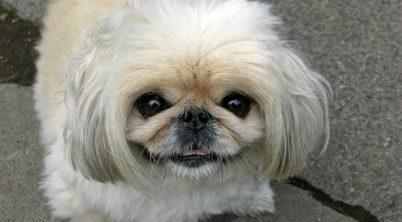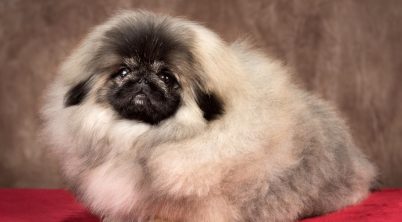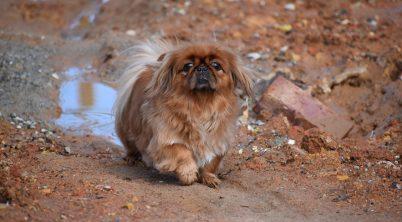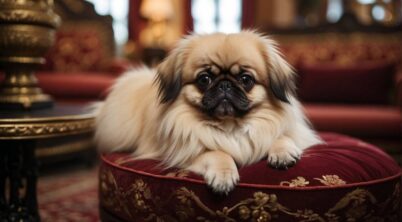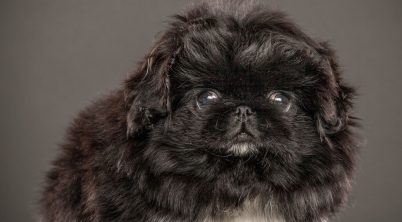The Pekingese is a canine breed steeped in rich history, harking back to the imperial courts of ancient China. Often seen as a symbol of nobility, the Pekingese was once the exclusive companion of Chinese royalty. With a lineage that traces back over two millennia, this breed is recognized as one of the oldest dog breeds in the world.
Characterized by its lion-like mane and small, compact body, the Pekingese’s unique appearance is attributed to selective breeding. In the imperial era, the breed was developed to resemble the mythic Chinese guardian lions which symbolized protection and power. This resonates with the legends surrounding the breed’s origins, which suggest a close association with Chinese lions.
The Pekingese owes its name to the city of Beijing, formerly known as Peking, where the Forbidden City, a historical landmark and home to the Imperial family, is situated. Despite its ancient roots, the Pekingese continues to charm dog enthusiasts globally with its dignified demeanor and affectionate nature, encapsulating a living piece of Chinese heritage.
Table of Contents
Oldest Pekingese
The Pekingese breed has a long-established history, tracing back its lineage to the imperial courts of China. While the typical lifespan for a Pekingese is between 12 to 15 years, exceptional longevity is not unheard of within the breed. Records indicate that the oldest Pekingese lived to an impressive age of 23 years, a feat that is significantly above the average.
Factors contributing to the lifespan of a Pekingese include:
- Genetic makeup: Some lineages may inherently live longer.
- Healthcare: Access to quality veterinary care can extend a Pekingese’s life.
- Diet: A balanced diet tailored to their needs is crucial.
- Exercise: Regular, gentle exercise helps maintain their health.
It is important to note that such extended lifespans are outliers and not the norm for the breed. Most Pekingese will have lifespans closer to the average range. Here’s a brief overview:
| Average Lifespan | Notable Outlier |
|---|---|
| 11.4 – 15 years | 23 years |
Owners seeking to maximize their Pekingese’s health and longevity should focus on preventative care, ensuring that their pets are not only well-fed and exercised but also regularly checked by a veterinarian for any potential health issues. As with all dogs, a nurturing home environment also plays a significant role in the health and well-being of the animal, potentially impacting its lifespan.
Historical Significance
The Pekingese breed holds a venerable position through Chinese history, closely intertwined with imperial splendor and international conflicts that affected its spread around the globe.
Origins in Ancient China
Dating back over 2,000 years, the Pekingese—or Peke—roots itself deeply within Ancient China. The breed is thought to have descended from lions bestowed with a diminutive form through the intervention of a compassionate Buddhist monk. These dogs not only gained reverence for their lion-like appearance but also for embodying Buddhist principles of spirituality and loyalty.
Pekingese and Chinese Royalty
The imperious nature of the Pekingese is no coincidence as it became the treasured companion of the Chinese Imperial Court and the Manchu Imperial family. These dogs lived in luxury, often owned by royals such as Empress Dowager Cixi. Beyond mere pets, the Pekingese served as a symbol of the regal opulence and sequestered lifestyles led by Chinese royalty, ensconced within the walls of the Forbidden City and the Old Summer Palace (Yuanmingyuan).
Influence of the Opium Wars
During the Second Opium War, the allure of Pekingese reached a grim turning point. In 1860, as British and French troops invaded Beijing, an elderly aunt of the Emperor committed suicide, leaving behind five Pekingese dogs. These were taken and one was presented to Queen Victoria of Britain, named “Looty.” Through such turbulent events, the Pekingese breed was disseminated to the West, becoming a coveted companion among the likes of Captain John Hart Dunne, the Duchess of Wellington, prominent Americans such as John Pierpont Morgan, and Alice Lee Roosevelt Longworth, the daughter of President Theodore Roosevelt. The breed’s historical course demonstrates the deep cultural interchange catalyzed by moments of conflict and conquest.
Breed Characteristics
The Pekingese is a breed with distinctive physical characteristics, which can be traced back to its historical status as a favored companion in Chinese imperial courts. Its features, such as a lion-like mane and rolling gait, reflect its breeding for appearance as much as companionship.
Physical Appearance
A Pekingese carries itself with an aura of dignity, likely a result of its royal heritage. The breed has a short snout, large eyes, and a V-shaped wrinkle on its face. Their overall appearance is reminiscent of a lion, which is why they are often referred to as “lion dogs”. Most noticeable is their rolling gait, a unique attribute that adds to their regal bearing.
Size and Proportion
The height of a Pekingese ranges from 6-8 inches at the shoulder, presenting a low-to-the-ground silhouette. They possess a stocky and muscular build, with a body weight that can reach up to 14 pounds. A Pekingese with a weight exceeding this limit is typically disqualified in conformation shows, as per breed standards set by kennel clubs.
Coat and Colors
The coat of a Pekingese is one of its most striking features, long and flowing, often described as a “lion’s mane”. The texture of their coat ranges from soft and wavy to slightly harsh, but always with an abundant mane and feathering on the ears, legs, and tail. Pekingese come in a variety of colors, such as tan, red, gold, white, black, sable, cream, and even blue. Breeders and enthusiasts often seek to match the coat color to the breed standard for show purposes, but all color variations are equally recognized within the breed with no preference given for one over another.
Temperament and Behavior
The Pekingese, a toy dog breed with ancient Chinese origins, is renowned for its distinct temperament and behavior, characterized by a mix of affectionate loyalty and confident independence. These traits are often manifest in their interactions with their families, including children.
Personality Traits
The Pekingese exhibits a complex personality that balances affection and independence. They tend to form strong bonds with their families, displaying loyalty and devotion. Despite their small size, the breed often carries itself with a confident demeanor that reflects its storied history associated with Chinese nobility and even the legend of the Buddha. Key personality traits of the Pekingese include:
- Affectionate: They express love towards their family members through close companionship.
- Loyal: Their devotion to family can be intense, often leading them to be protective.
- Independent: A Pekingese may seek out personal space, a trait owners should respect.
- Confident: They carry a self-assured attitude that belies their diminutive stature.
Interaction with Families and Children
While generally good with families, the Pekingese may have certain reservations when it comes to children. Due to their small size and assurance in their self-worth, they are best suited to a family that can approach them with gentle respect. Key considerations include:
- Interaction with Families:
- Ideally suited to families that understand and appreciate the Pekingese’s noble background.
- Thrives in environments where they are treated as a loyal pet and valued family member.
- Interaction with Children:
- Children should be taught to interact with the Pekingese calmly and with care to foster mutual respect.
- Due to their independent nature, Pekingese may not tolerate rough play and should be monitored around younger children.
Health and Wellness
Maintaining optimal health is crucial for the Pekingese, with a life expectancy ranging from 12 to 14 years. Regular grooming and vet check-ups play a significant role in identifying and managing prevalent health issues early.
Common Health Issues
The Pekingese breed is predisposed to certain health issues that can affect their quality of life. These include:
- Brachycephalic Airway Obstruction Syndrome (BAOS): Due to their brachycephalic (flat-faced) nature, Pekingese can suffer from breathing problems.
- Obesity: A common concern which can exacerbate respiratory issues and put undue stress on their joints.
- Joint Issues: Such as patellar luxation, which is relatively common in small breeds.
- Eye Conditions: Due to their prominent eyes, they are more susceptible to corneal abrasions and ulcers.
They also have a double coat that sheds seasonally, requiring grooming to remove loose fur and prevent matting. Regular brushing distributes skin oils throughout the coat, keeping it healthy.
Exercise and Activity Levels
Pekingese have moderate exercise needs. They benefit from:
- Daily walks: To maintain a healthy weight and stave off obesity.
- Play sessions: To keep them engaged and active.
However, because of their susceptibility to heat stroke and breathing complications, activities should be tailored to avoid overexertion, especially in hot weather. Indoor play and exercise in a climate-controlled environment can be beneficial for this breed.
Caring for a Pekingese
Proper care for a Pekingese involves meticulous grooming, a well-balanced diet, and consistent training and socialization to ensure their well-being.
Grooming Needs
A Pekingese’s coat requires regular attention to maintain its health and appearance. Weekly brushing is essential to prevent matting and to manage shedding. Their double coat consists of a thick undercoat and a longer outer coat, necessitating the use of both a bristle brush and a fine-toothed comb. Special care must be taken around the face to gently clean the eye area and avoid infection.
Dietary Considerations
These small dogs benefit from a diet that supports their energy levels without causing weight gain, which can lead to health problems. An adult Pekingese typically needs about 0.75 cups of high-quality dog food daily, but puppies require more frequent feeding. Ensure that their food is rich in protein and includes fruits and vegetables to support overall health. The caloric intake should be monitored, particularly for less active dogs, to avoid obesity.
Training and Socialization
Training a Pekingese should employ positive reinforcement techniques, as they respond well to rewards and praise. Start training early to establish good behaviors and socialization habits. Consistent training sessions help in nurturing a well-mannered pet. Regular walks and playtime are crucial to keep them socialized with other dogs and humans, aiding in the development of a friendly and adaptable demeanor. Despite their small size, they require sufficient mental and physical stimulation to prevent boredom and promote good behaviors.

